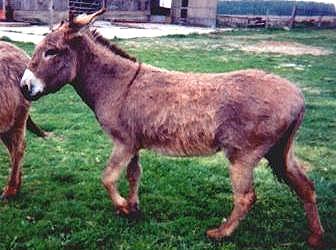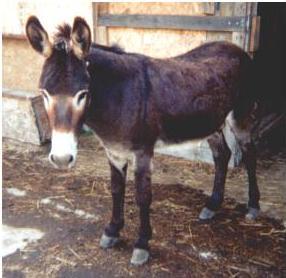| Introduction
to Donkeys and People:
Communication
It is my experience
and observation that most horse training methods have only a marginal success
training donkeys. Donkeys are not like horses; mentally, physically, and
most of all, emotionally.
Horses are grazers.
They have a high metabolic rate and will graze 18 to 20 hours a day to
maintain their body weight. Donkeys
are browsers. They nibble for a while on whatever is available, then nap,
conserving their energy.
Horses are herd
animals and prefer to be in a large group.
 Donkeys
are buddy animals. They usually pair off in twos. Donkeys
are buddy animals. They usually pair off in twos.
Nature provided
horses with a strong flight instinct and long legs so they could run to
escape predators. Horses easily startle.
 Donkeys
are not easily startled. They have a keen sense of curiosity. They may
run a short distance but then they stop and turn to face whatever scared
them before they MAKE A DECISION whether to stand still or continue fleeing. Donkeys
are not easily startled. They have a keen sense of curiosity. They may
run a short distance but then they stop and turn to face whatever scared
them before they MAKE A DECISION whether to stand still or continue fleeing.
Most horse training
methods rely on a horse's reaction to a pecking order in the herd. The
horse trainer becomes the Boss Horse of the herd to teach a horse to react
to a cue for a particular action.
Donkeys
are more independent in their thinking. If you attempt to dominate the
donkey, he will just avoid you. Donkeys do think. They do reason. They
do make decisions. They can learn what it is we would like for them to
do if we take the time to explain it to them.
Donkeysare
better at reading our body language than we are at reading theirs. If you
are nervous and anxious, they will be nervous and anxious too. Calm, slow
movements assure the donkey there is nothing to fear. They can also learn
what a particular sound means. Notice I did not say word. It is the vowel
and consonant sounds and tone of your voice that they understand. Because
of the long "O" sound, if you chase after a donkey and yell Whoa! He may
think you are shouting for him to Go! He did not see the tiger creeping
in the grass but you must have seen it because you are excited and are
running, so he will too. He is relying on his new buddy, You to warn him
of danger. If you are also dragging a lead rope behind you while you chase
after him, I imagine he is grateful you sacrificed yourself to the snake
just so he could get away. A snake is what a lead rope would look like
to a donkey.
To communicate
with a donkey we have to stop seeing the world as we see it and look at
it from a donkey's perspective. The saddle we want to put on him would
trigger a natural fear of a predator jumping on his back. The cart we want
to hitch him to could be a falling timber that he has to outrun so it does
not roll over him and break his leg. The shallow creek could be quicksand
or it could be concealing a lurking alligator. The horse trailer we want
him to climb in could look like a cave. A bear cave. It is dark and narrow
and he can not see an exit on the other end. He would be trapped if the
bear came home.
A donkey's strongest
instinct is survival. Training a donkey relies on showing him by words
and actions that he can trust you to protect him from harm.
Stick a hunk of
metal in his mouth and yank on it and he is going to feel pain. It does
not take long for him to associate that pain with you. You caused him pain.
You failed to protect him. Slap him with a whip to make him move at the
same time you are yanking this way or that way on the reins and you are
compounding your offense by now causing him pain at both ends of his body.
In his mind You are NOT his friend.
Communicate your
requests to him without pain or fear and you will have a willing, happy
donkey buddy.
The first step
to training a donkey is training yourself to observe his body language.
Learn to recognize what he is saying to you.

Pumpkin is lowering
his head, tucking his tail and moving away. He is saying, "No. Leave me
alone."

Snow Dragon Hank
is standing with his neck up, his ears perked, and his body weight shifted
forward in a pre-flight stance. He sees, hears, or smells something that
could be a threat.

Katie is afraid.
Her head is up and her tail is clamped against her body.

Jasper is in a
welcoming stance inviting human contact.
Donkeys love to
play. They love a challenge. If the training is fun for him he will learn
faster.


A donkey is stronger
than a horse of the same size. You can not muscle a donkey. You can not
force him. He has to understand what it is you are asking him to do.
To learn what
your donkey is saying watch his ears, his tail, and the way he shifts his
body weight. Is he looking straight at you? Or is he avoiding eye contact?
Does his body language and facial expression remind you of: A bratty child?
An angry child? A disappointed child? A frightened child? A bright-eyed
eager, curious child?
There are actually
many similarities between a donkey and a child. They both will place their
trust in you. Both must be handled with patience and understanding. Both
will love you unconditionally, warts and mistakes and all. Both can fill
your life with love and joy. Both can be your very best buddy.
When you begin
to train your donkey remember back to when you were a child and you were
trying to learn how to ride a bicycle. You knew you could do it but those
first few attempts without the training wheels were frustrating because
you could not pedal and steer at the same time. That is the same emotion
your donkey must feel when he is trying his best to do what you want him
to do but you keep correcting him for every little thing he does wrong.
Do not expect him to do it 100% the first time or even the second time.
You have to allow him to build his own confidence in his ability before
you can begin refining his actions. If he takes one step in the direction
you want him to go, praise him. This is all new and different to him but
he is willing to try to please you.
 His
mother communicated with him by nudges and grunts. A short tug and release
is similar to his mother's nudge. That is something he already understands.
Notice how Pumpkin's reins are slack while he is turning. His cue was a
short tug and release repeated until he began the requested movement and
then the tug and release stopped rewarding him for making an effort to
comply with the request for a turn. His
mother communicated with him by nudges and grunts. A short tug and release
is similar to his mother's nudge. That is something he already understands.
Notice how Pumpkin's reins are slack while he is turning. His cue was a
short tug and release repeated until he began the requested movement and
then the tug and release stopped rewarding him for making an effort to
comply with the request for a turn.
|



